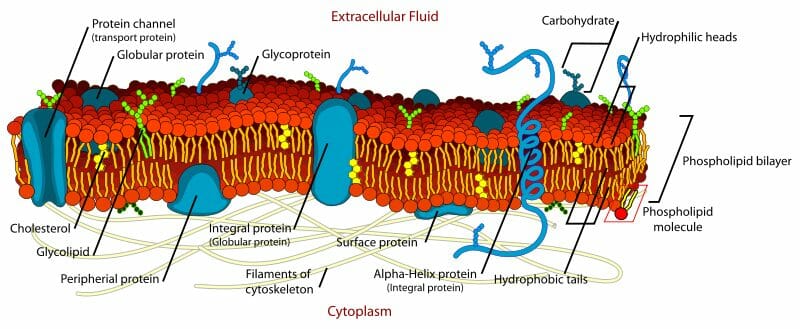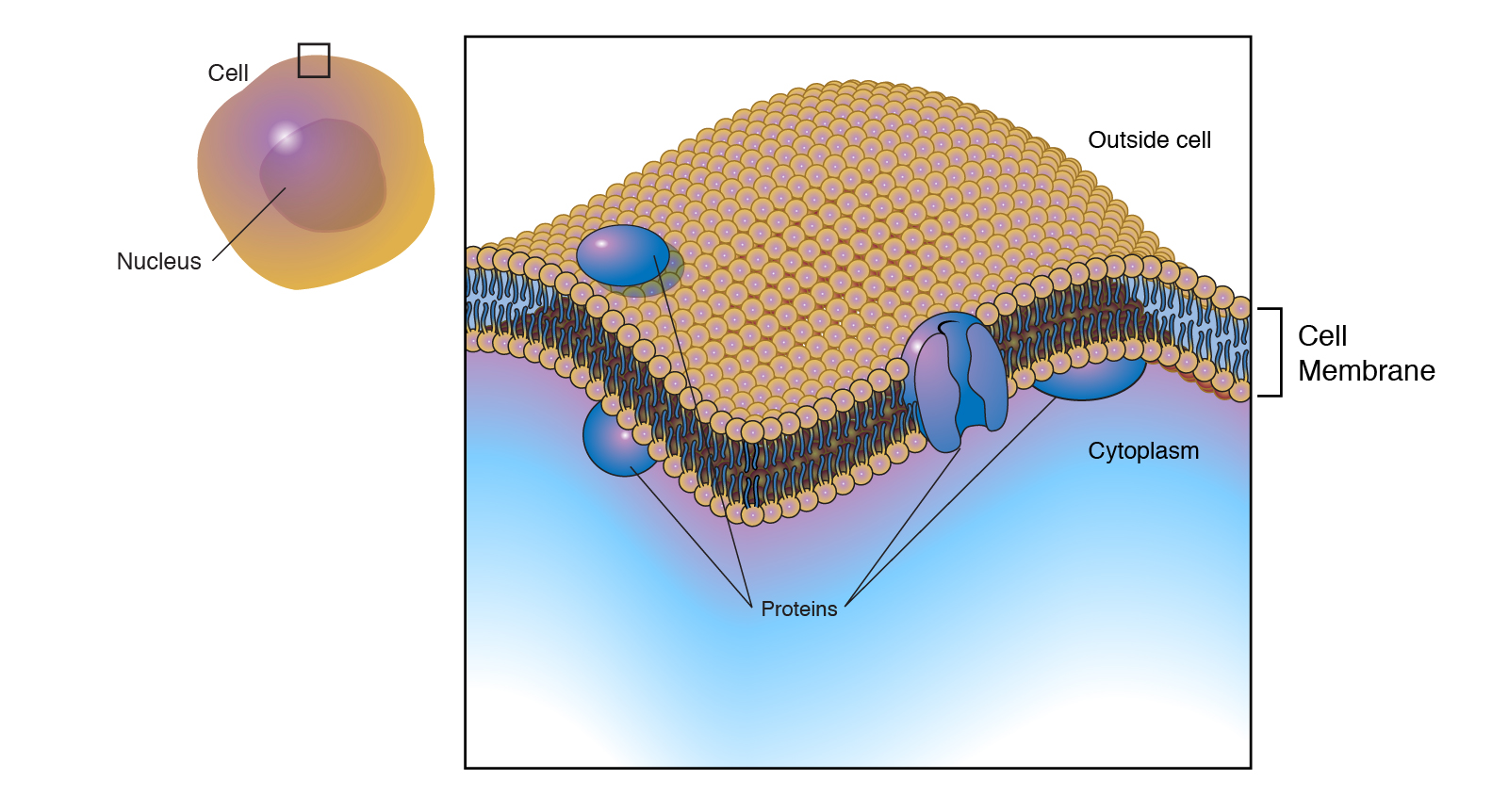2 What Model Is Used to Describe the Plasma Membrane
The fluid mosaic model of the plasma membrane. The model has evolved but it still accurately summarizes the structure and functions of the plasma membrane.

Hydropathicity Plots Plasma Membrane Cell Membrane Cell Membrane Structure
The explanation the fluid mosaic model has evolved somewhat over time but it still best accounts for plasma membrane structure and function as we now understand them.

. Singer and Garth L. The fluid mosaic model describes the structure of the plasma membrane as a mosaic of components including phospholipids cholesterol proteins and carbohydratesthat gives the membrane a fluid character. The following points highlight the top four historical models of Plasma Membrane.
What term is used to describe the plasma membrane and all layers external to it. Evert Gorter and François Grendel Dutch physiologists approached the discovery of our present model of the plasma membrane structure as a lipid bi-layerThey simply hypothesized that if the plasma membrane is a bi-layer then the surface area of the mono-layer of lipids measured would be double the surface area of the plasma membrane. Lipid and Lipid Bilayer Model.
Section 24 of the AP Biology curriculum takes a close look at the structure of the Plasma Membrane. All cells contain ion pumps that use the energy of ATP hydrolysis to pump ions across the plasma membrane. These components work together in a theory known as the fluid mosaic model that describes the.
The model that is used to describe the plasma membrane is called the _ fluid-mosaic _ Model. The plasma membrane contains protein molecules that are embedded in the phospholipid bilayer. Singer and Nicholson proposed a model to describe how lipids behave in a membrane called the _____ _____ model.
Answered by Sulekha Shah. Match the membrane protein to its function. The model has evolved somewhat over time but it still best accounts for the structure and functions of the plasma membrane as we now understand them.
The plasma membranes have two layers of phospholipids in which proteins are present. Lipid and Lipid Bilayer Models 2. The mosaic model of membrane structure describes the structure of the plasma membrane as a mosaic of components including phospholipids proteins carbohydrates cholesterol and proteins that gives the membrane a fluid character.
The hydrophobic fatty acid tails of phospholipid layers make the inner core of the membranes. The Fluid Mosaic Model is used to describe the plasma membrane structure. Biology questions and answers.
The pattern of proteins within it constantly changes. The fluid mosaic model is a model that scientists use to describe the structure of the plasma membrane. The plasma membrane may be known as a fluid mosaic model where the membrane is a fluid structure with various proteins.
Its arranged this way to give it a flexible structure and it keeps the cell separate from its environment. Cell Recognition Protein f. Nicolson proposed a new model that provides microscopic observations and better explains plasma membrane function.
For example myelin contains 18 protein and 76 lipid. The fluid mosaic model was first proposed by SJ. A cells plasma membrane is dynamic.
The fluid mosaic model describes the plasma. First the CG model of α-TTP-PIP 2 lipid bilayer are used to identify the global behavior of α-TTP in the presence of a PIP 2-rich membrane model. However the tails are not bonded to each other and make a fluid-like base in which proteins are present.
The plasma membrane is fluid meaning that the components drift around freely in a lateral way. The cell membrane is described as a fluid mosaic to indicate that it is not a rigid structure and the phospholipid bilayer behaves like a fluid more than like a solid. The term used to describe the plasma membrane because of its oily nature and embedded proteins is the fluid-mosaic model.
To examine their hypothesis they. The fluid mosaic model of the plasma membrane describes the plasma membrane as a fluid combination of phospholipids cholesterol and proteins. The DavsonDanielli model or paucimolecular model was a model of the plasma membrane of a cell proposed in 1935 by Hugh Davson and James Danielli.
Although this model has undergone several changes over time since it was proposed in 1972 the fluid mosaic model is the model often used to describe the structure of plasma membrane. The model describes a phospholipid bilayer that lies between two layers of globular proteins and it is trilaminar and lipoproteinous. According to this model the plasma membrane is composed of freely moving in a fluid-like manner components phospholipids proteins and cholesterol.
This model to explain the structure of plasma membrane was given by Overton Gorion. Unit Membrane Model Protein-Lipid Bilayer-Protein 3. Singer and Garth L.
Its consistency has been. This section looks at the components necessary to create functional cell membranes such as phospholipids membrane proteins and other components. These pumps create an electrochemical gradient across the plasma membrane that is used to power other processes at the plasma membrane including some transport processes.
Carbohydrates attached to lipids glycolipids and to proteins glycoproteins extend from the outward-facing surface of the membrane. Fluid Mosaic Model 4. Scientists use the fluid mosaic model to describe the structure of a plasma membrane.
In animal cells the main ion pump is the sodium-potassium pump. Nicolson in 1972 to explain the structure of the plasma membrane. The plasma membrane is made up of carbohydrates cholesterol proteins and a lipid bilayer or double layer of lipids.
That makes up nearly all of the plasma membrane. The fluid mosaic model of the plasma membrane describes the. April 6 2021 by Sagar Aryal.
Plasma membranes range from 5 to 10 nm in thickness. Identify any of the following that has an association with the bacterial plasma membrane. The plasma membrane is a semi permeable barrier that separates the inside of the cell from the outside environment.
Then full atomistic models are used to refine the description of the molecular interactions and conformational dynamics responsible for the anchoring of α-TTP to a model of the plasma membrane. The fluid mosaic model of the plasma membrane describes that the plasma membrane is only made of water that has phospholipids that float in it d. 1 Explain what is meant by fluid mosaic 2 Explain how the plasma membrane fits the structure.
The fluid mosaic model of the plasma membrane describes that the plasma membrane has different types of phospholipids which are only hydrophilic c.

Plasma Membrane Definition Structure Functions Biology Dictionary


No comments for "2 What Model Is Used to Describe the Plasma Membrane"
Post a Comment